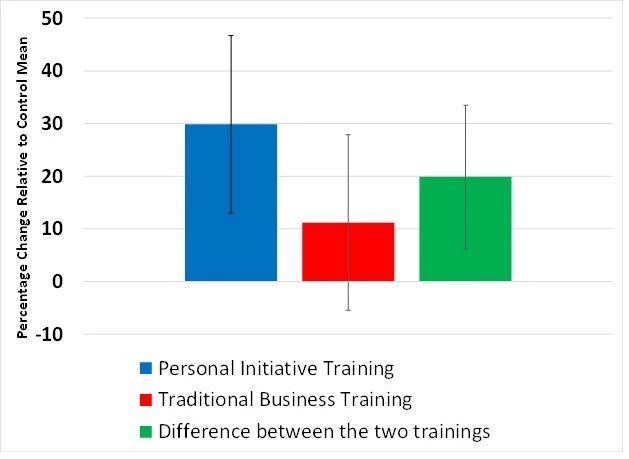Billions of dollars have been spent by governments, microfinance organizations, and NGOs on training small businesses. Traditional training programs typically aim to teach owners to use better business practices such as record-keeping, stock control, and simple marketing. But while
employing more of these practices does seem to improve firm performance,
most attempts to train firm owners result in only a small change in these practices, making it hard to detect any impact on firm performance. So when we were approached in late 2012 to design an impact evaluation for a training program to be offered in Togo under a World Bank loan program, we proposed that the training program that they had planned on offering (the
IFC’s
Business Edge program) be tested against an alternative approach.
The alternative approach came from partnering with psychologist Michael Frese, who had been working on developing a personal initiative training program that aims to develop behaviors associated with a pro-active entrepreneurial mindset, rather than teaching basic business skills. The idea is to teach small business owners to try to find ways to innovate and differentiate themselves from other businesses, to anticipate problems and constantly look for new opportunities to exploit, to overcome obstacles, and to be self-starting. Working with Michael, his PhD student Mona Mensmann, and World Bank colleagues Francisco Campos, Leonardo Iacovone and Hillary Johnson, we conducted a randomized controlled trial that tested these two approaches, with the findings released in Science today.
Context and Random Assignment
The World Bank project launched a communication campaign in Lomé, the capital city of Togo, to seek businesses from the informal sector interested in improving and growing their businesses. More than 3,200 businesses applied, and these were screened to a sample of 1,500 businesses who received a baseline survey in the last quarter of 2013. The businesses came from a broad mix of industries (27% manufacturing, 48% commerce, 25% services), were almost equally split by gender of the owner (53% female), and were earning a mean of $200 per month in profits. Firms had a mean of three employees and median of two.

These firms were then randomly assigned into three groups, each of 500 firms:
Both training courses were implemented in three half-day sessions per week in April 2014, for a total of 36 hours, followed by a trainer visiting the business once a month over the next 4 months to reinforce the concepts. The cost of providing each training course was approximately $750 per participant, but it was offered at a highly subsidized rate of around $10. Take-up rates were high, with 84 percent of those invited to training participating in each treatment group.
What was the impact of these training programs on business growth?
We collected four rounds of follow-up surveys between September 2014 and September 2016, enabling us to track the outcomes of these businesses for 2 years and 5 months after training. Survey attrition rates were low, averaging 9 percent. Using the random assignment across groups, we can then compare how similar businesses performed over time when their owners were invited to either training program, compared to being in the control group.
Figure 1 shows one headline finding: personal initiative training increased firm profits by 30 percent, compared to a statistically insignificant 11 percent for traditional training, with the difference between the two trainings also statistically significant. We show in the paper that this increase is not driven by a few really successful firms, but occurs across the distribution. Firms taking part in personal initiative training also have a 17 percent increase in monthly sales compared to the control group.
Figure 1: Personal Initiative Training Raised Monthly Profits by More than Traditional Training

Note: vertical lines show 95 percent confidence intervals. Estimates are average effects over all four rounds of post-training surveys.
This increase in monthly profits equates to $60 more per month; enough to pay back the cost of offering the training within one year. A lower bound on the return on investment is 82 percent, with the estimated 10-year return ranging from 140 to 393 percent depending on how long these benefits last.
How does personal initiative training spur greater firm growth?
We explore a number of different mechanisms to help understand why this new training program out-performs the traditional approach:
These results highlight the promise for improving the standard approach to training entrepreneurs by using insights from psychology. Based on these results, personal initiative training has already been incorporated into new training programs in Ethiopia, Jamaica, and Mexico, and we look forward to seeing whether it can also develop more successful entrepreneurs in these other settings.
The alternative approach came from partnering with psychologist Michael Frese, who had been working on developing a personal initiative training program that aims to develop behaviors associated with a pro-active entrepreneurial mindset, rather than teaching basic business skills. The idea is to teach small business owners to try to find ways to innovate and differentiate themselves from other businesses, to anticipate problems and constantly look for new opportunities to exploit, to overcome obstacles, and to be self-starting. Working with Michael, his PhD student Mona Mensmann, and World Bank colleagues Francisco Campos, Leonardo Iacovone and Hillary Johnson, we conducted a randomized controlled trial that tested these two approaches, with the findings released in Science today.
Context and Random Assignment
The World Bank project launched a communication campaign in Lomé, the capital city of Togo, to seek businesses from the informal sector interested in improving and growing their businesses. More than 3,200 businesses applied, and these were screened to a sample of 1,500 businesses who received a baseline survey in the last quarter of 2013. The businesses came from a broad mix of industries (27% manufacturing, 48% commerce, 25% services), were almost equally split by gender of the owner (53% female), and were earning a mean of $200 per month in profits. Firms had a mean of three employees and median of two.

These firms were then randomly assigned into three groups, each of 500 firms:
- A control group, which did not receive any business training.
- A traditional business training group which received the Business Edge training program, which focused on four core topics: accounting and financial management, human resource management, marketing, and formalization.
- The personal initiative training group, who were offered this new program focused on teaching a mindset of self-starting, proactive behavior.
Both training courses were implemented in three half-day sessions per week in April 2014, for a total of 36 hours, followed by a trainer visiting the business once a month over the next 4 months to reinforce the concepts. The cost of providing each training course was approximately $750 per participant, but it was offered at a highly subsidized rate of around $10. Take-up rates were high, with 84 percent of those invited to training participating in each treatment group.
What was the impact of these training programs on business growth?
We collected four rounds of follow-up surveys between September 2014 and September 2016, enabling us to track the outcomes of these businesses for 2 years and 5 months after training. Survey attrition rates were low, averaging 9 percent. Using the random assignment across groups, we can then compare how similar businesses performed over time when their owners were invited to either training program, compared to being in the control group.
Figure 1 shows one headline finding: personal initiative training increased firm profits by 30 percent, compared to a statistically insignificant 11 percent for traditional training, with the difference between the two trainings also statistically significant. We show in the paper that this increase is not driven by a few really successful firms, but occurs across the distribution. Firms taking part in personal initiative training also have a 17 percent increase in monthly sales compared to the control group.
Figure 1: Personal Initiative Training Raised Monthly Profits by More than Traditional Training

Note: vertical lines show 95 percent confidence intervals. Estimates are average effects over all four rounds of post-training surveys.
This increase in monthly profits equates to $60 more per month; enough to pay back the cost of offering the training within one year. A lower bound on the return on investment is 82 percent, with the estimated 10-year return ranging from 140 to 393 percent depending on how long these benefits last.
How does personal initiative training spur greater firm growth?
We explore a number of different mechanisms to help understand why this new training program out-performs the traditional approach:
- The traditional approach does lead to an increase in the use of standard business practices like accounting, marketing, and stock control. However, even without explicitly teaching these practices, firms getting personal initiative training adopt almost as many of these practices.
- Personal initiative training does result in a much larger increase in personal initiative than traditional training, which we measure using both a seven-item scale of agreement with questions like “I actively attack problems” and “whenever something goes wrong, I search immediately for solutions”, as well as questions which are coded based on answers to open-ended questions of what changes the owner has made in the business, and how they got the idea for this change and went about implementing it.
- Those receiving personal initiative training engaged in more innovation, introducing more new products, and being more likely to diversify into a new product line than those in traditional training.
- After personal initiative training, firm owners borrowed more and made more larger investments.
These results highlight the promise for improving the standard approach to training entrepreneurs by using insights from psychology. Based on these results, personal initiative training has already been incorporated into new training programs in Ethiopia, Jamaica, and Mexico, and we look forward to seeing whether it can also develop more successful entrepreneurs in these other settings.



Join the Conversation